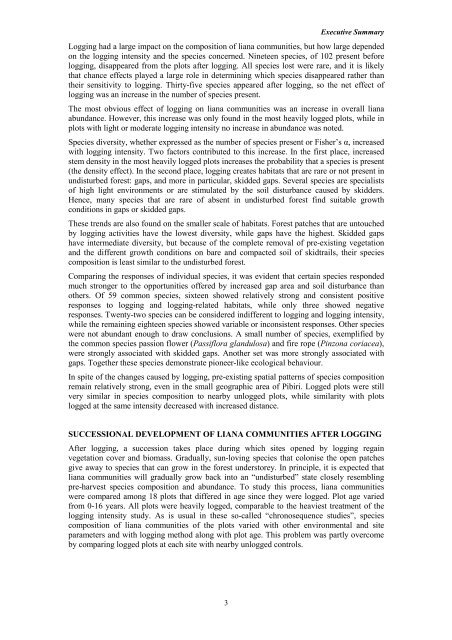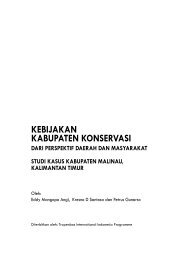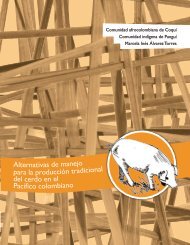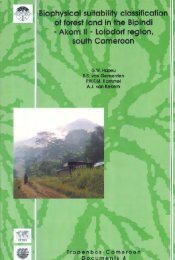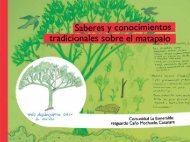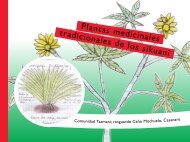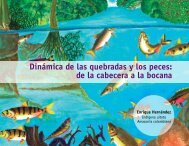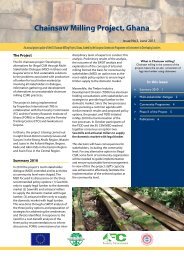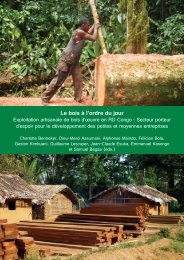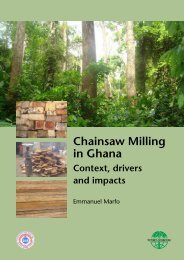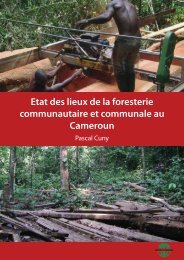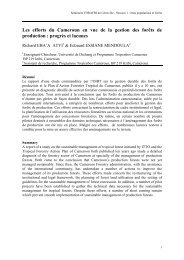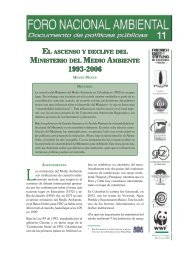Logging effects on liana diversity and abundance in Central Guyana
Logging effects on liana diversity and abundance in Central Guyana
Logging effects on liana diversity and abundance in Central Guyana
Create successful ePaper yourself
Turn your PDF publications into a flip-book with our unique Google optimized e-Paper software.
Executive Summary<br />
<str<strong>on</strong>g>Logg<strong>in</strong>g</str<strong>on</strong>g> had a large impact <strong>on</strong> the compositi<strong>on</strong> of <strong>liana</strong> communities, but how large depended<br />
<strong>on</strong> the logg<strong>in</strong>g <strong>in</strong>tensity <strong>and</strong> the species c<strong>on</strong>cerned. N<strong>in</strong>eteen species, of 102 present before<br />
logg<strong>in</strong>g, disappeared from the plots after logg<strong>in</strong>g. All species lost were rare, <strong>and</strong> it is likely<br />
that chance <str<strong>on</strong>g>effects</str<strong>on</strong>g> played a large role <strong>in</strong> determ<strong>in</strong><strong>in</strong>g which species disappeared rather than<br />
their sensitivity to logg<strong>in</strong>g. Thirty-five species appeared after logg<strong>in</strong>g, so the net effect of<br />
logg<strong>in</strong>g was an <strong>in</strong>crease <strong>in</strong> the number of species present.<br />
The most obvious effect of logg<strong>in</strong>g <strong>on</strong> <strong>liana</strong> communities was an <strong>in</strong>crease <strong>in</strong> overall <strong>liana</strong><br />
<strong>abundance</strong>. However, this <strong>in</strong>crease was <strong>on</strong>ly found <strong>in</strong> the most heavily logged plots, while <strong>in</strong><br />
plots with light or moderate logg<strong>in</strong>g <strong>in</strong>tensity no <strong>in</strong>crease <strong>in</strong> <strong>abundance</strong> was noted.<br />
Species <strong>diversity</strong>, whether expressed as the number of species present or Fisher’s α, <strong>in</strong>creased<br />
with logg<strong>in</strong>g <strong>in</strong>tensity. Two factors c<strong>on</strong>tributed to this <strong>in</strong>crease. In the first place, <strong>in</strong>creased<br />
stem density <strong>in</strong> the most heavily logged plots <strong>in</strong>creases the probability that a species is present<br />
(the density effect). In the sec<strong>on</strong>d place, logg<strong>in</strong>g creates habitats that are rare or not present <strong>in</strong><br />
undisturbed forest: gaps, <strong>and</strong> more <strong>in</strong> particular, skidded gaps. Several species are specialists<br />
of high light envir<strong>on</strong>ments or are stimulated by the soil disturbance caused by skidders.<br />
Hence, many species that are rare of absent <strong>in</strong> undisturbed forest f<strong>in</strong>d suitable growth<br />
c<strong>on</strong>diti<strong>on</strong>s <strong>in</strong> gaps or skidded gaps.<br />
These trends are also found <strong>on</strong> the smaller scale of habitats. Forest patches that are untouched<br />
by logg<strong>in</strong>g activities have the lowest <strong>diversity</strong>, while gaps have the highest. Skidded gaps<br />
have <strong>in</strong>termediate <strong>diversity</strong>, but because of the complete removal of pre-exist<strong>in</strong>g vegetati<strong>on</strong><br />
<strong>and</strong> the different growth c<strong>on</strong>diti<strong>on</strong>s <strong>on</strong> bare <strong>and</strong> compacted soil of skidtrails, their species<br />
compositi<strong>on</strong> is least similar to the undisturbed forest.<br />
Compar<strong>in</strong>g the resp<strong>on</strong>ses of <strong>in</strong>dividual species, it was evident that certa<strong>in</strong> species resp<strong>on</strong>ded<br />
much str<strong>on</strong>ger to the opportunities offered by <strong>in</strong>creased gap area <strong>and</strong> soil disturbance than<br />
others. Of 59 comm<strong>on</strong> species, sixteen showed relatively str<strong>on</strong>g <strong>and</strong> c<strong>on</strong>sistent positive<br />
resp<strong>on</strong>ses to logg<strong>in</strong>g <strong>and</strong> logg<strong>in</strong>g-related habitats, while <strong>on</strong>ly three showed negative<br />
resp<strong>on</strong>ses. Twenty-two species can be c<strong>on</strong>sidered <strong>in</strong>different to logg<strong>in</strong>g <strong>and</strong> logg<strong>in</strong>g <strong>in</strong>tensity,<br />
while the rema<strong>in</strong><strong>in</strong>g eighteen species showed variable or <strong>in</strong>c<strong>on</strong>sistent resp<strong>on</strong>ses. Other species<br />
were not abundant enough to draw c<strong>on</strong>clusi<strong>on</strong>s. A small number of species, exemplified by<br />
the comm<strong>on</strong> species passi<strong>on</strong> flower (Passiflora gl<strong>and</strong>ulosa) <strong>and</strong> fire rope (P<strong>in</strong>z<strong>on</strong>a coriacea),<br />
were str<strong>on</strong>gly associated with skidded gaps. Another set was more str<strong>on</strong>gly associated with<br />
gaps. Together these species dem<strong>on</strong>strate pi<strong>on</strong>eer-like ecological behaviour.<br />
In spite of the changes caused by logg<strong>in</strong>g, pre-exist<strong>in</strong>g spatial patterns of species compositi<strong>on</strong><br />
rema<strong>in</strong> relatively str<strong>on</strong>g, even <strong>in</strong> the small geographic area of Pibiri. Logged plots were still<br />
very similar <strong>in</strong> species compositi<strong>on</strong> to nearby unlogged plots, while similarity with plots<br />
logged at the same <strong>in</strong>tensity decreased with <strong>in</strong>creased distance.<br />
SUCCESSIONAL DEVELOPMENT OF LIANA COMMUNITIES AFTER LOGGING<br />
After logg<strong>in</strong>g, a successi<strong>on</strong> takes place dur<strong>in</strong>g which sites opened by logg<strong>in</strong>g rega<strong>in</strong><br />
vegetati<strong>on</strong> cover <strong>and</strong> biomass. Gradually, sun-lov<strong>in</strong>g species that col<strong>on</strong>ise the open patches<br />
give away to species that can grow <strong>in</strong> the forest understorey. In pr<strong>in</strong>ciple, it is expected that<br />
<strong>liana</strong> communities will gradually grow back <strong>in</strong>to an “undisturbed” state closely resembl<strong>in</strong>g<br />
pre-harvest species compositi<strong>on</strong> <strong>and</strong> <strong>abundance</strong>. To study this process, <strong>liana</strong> communities<br />
were compared am<strong>on</strong>g 18 plots that differed <strong>in</strong> age s<strong>in</strong>ce they were logged. Plot age varied<br />
from 0-16 years. All plots were heavily logged, comparable to the heaviest treatment of the<br />
logg<strong>in</strong>g <strong>in</strong>tensity study. As is usual <strong>in</strong> these so-called “chr<strong>on</strong>osequence studies”, species<br />
compositi<strong>on</strong> of <strong>liana</strong> communities of the plots varied with other envir<strong>on</strong>mental <strong>and</strong> site<br />
parameters <strong>and</strong> with logg<strong>in</strong>g method al<strong>on</strong>g with plot age. This problem was partly overcome<br />
by compar<strong>in</strong>g logged plots at each site with nearby unlogged c<strong>on</strong>trols.<br />
3


